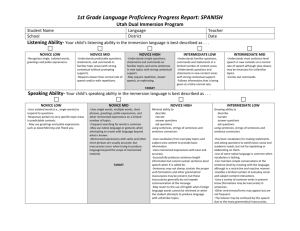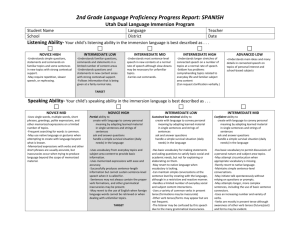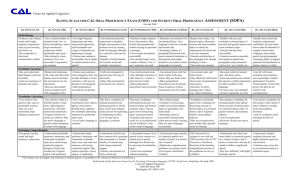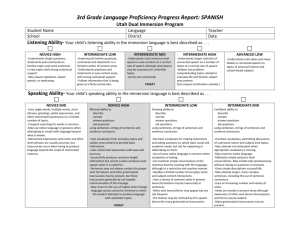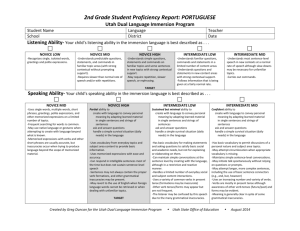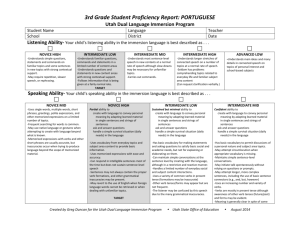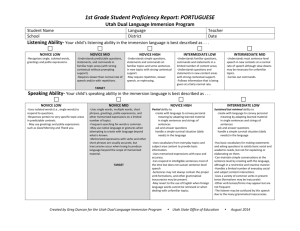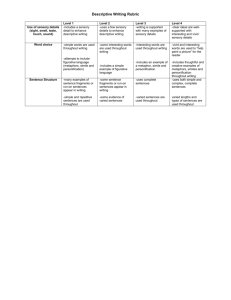1st Grade Spanish Proficiency Report - Utah Immersion
advertisement
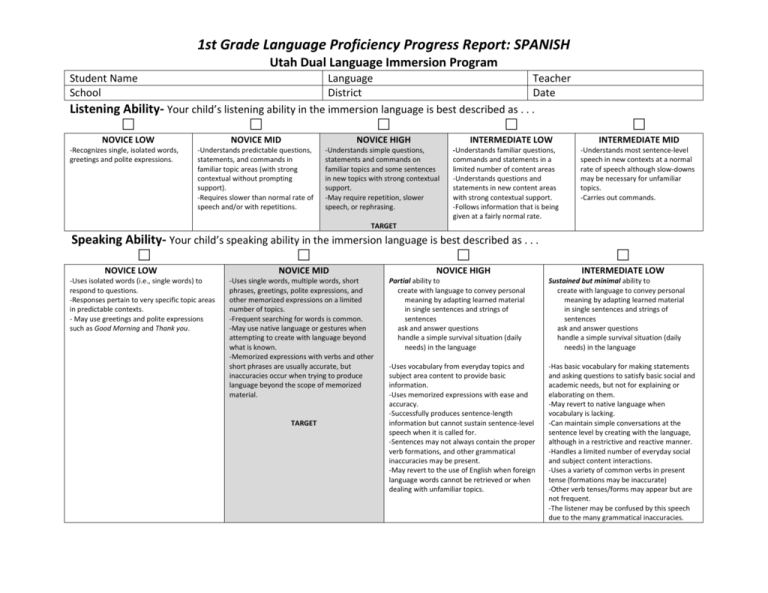
1st Grade Language Proficiency Progress Report: SPANISH Utah Dual Language Immersion Program Student Name School Language Teacher District Date Listening Ability- Your child’s listening ability in the immersion language is best described as . . . NOVICE LOW NOVICE MID NOVICE HIGH INTERMEDIATE LOW INTERMEDIATE MID -Understands predictable questions, statements, and commands in familiar topic areas (with strong contextual without prompting support). -Requires slower than normal rate of speech and/or with repetitions. -Understands simple questions, statements and commands on familiar topics and some sentences in new topics with strong contextual support. -May require repetition, slower speech, or rephrasing. -Recognizes single, isolated words, greetings and polite expressions. -Understands familiar questions, commands and statements in a limited number of content areas -Understands questions and statements in new content areas with strong contextual support. -Follows information that is being given at a fairly normal rate. -Understands most sentence-level speech in new contexts at a normal rate of speech although slow-downs may be necessary for unfamiliar topics. -Carries out commands. TARGET Speaking Ability- Your child’s speaking ability in the immersion language is best described as . . . NOVICE LOW -Uses isolated words (i.e., single words) to respond to questions. -Responses pertain to very specific topic areas in predictable contexts. - May use greetings and polite expressions such as Good Morning and Thank you. NOVICE MID NOVICE HIGH INTERMEDIATE LOW -Uses single words, multiple words, short phrases, greetings, polite expressions, and other memorized expressions on a limited number of topics. -Frequent searching for words is common. -May use native language or gestures when attempting to create with language beyond what is known. -Memorized expressions with verbs and other short phrases are usually accurate, but inaccuracies occur when trying to produce language beyond the scope of memorized material. TARGET Partial ability to create with language to convey personal meaning by adapting learned material in single sentences and strings of sentences ask and answer questions handle a simple survival situation (daily needs) in the language Sustained but minimal ability to create with language to convey personal meaning by adapting learned material in single sentences and strings of sentences ask and answer questions handle a simple survival situation (daily needs) in the language -Uses vocabulary from everyday topics and subject area content to provide basic information. -Uses memorized expressions with ease and accuracy. -Successfully produces sentence-length information but cannot sustain sentence-level speech when it is called for. -Sentences may not always contain the proper verb formations, and other grammatical inaccuracies may be present. -May revert to the use of English when foreign language words cannot be retrieved or when dealing with unfamiliar topics. -Has basic vocabulary for making statements and asking questions to satisfy basic social and academic needs, but not for explaining or elaborating on them. -May revert to native language when vocabulary is lacking. -Can maintain simple conversations at the sentence level by creating with the language, although in a restrictive and reactive manner. -Handles a limited number of everyday social and subject content interactions. -Uses a variety of common verbs in present tense (formations may be inaccurate) -Other verb tenses/forms may appear but are not frequent. -The listener may be confused by this speech due to the many grammatical inaccuracies. 1st Grade Language Proficiency Progress Report: SPANISH Utah Dual Language Immersion Program Reading Ability- Here are your child’s reading abilities in Spanish at the end of 1st Grade: C=Can do independently _____ 1. _____ 2. _____ 3. _____ 4. _____ 5. _____ 6. _____ 7. _____ 8. _____ 9. WH=Can do with help G=A goal Match the sound to the correct letter Decode by syllables Identify the message in common environmental print (i.e., signs, boxes, wrappers) Follow along on the page when the text is being read aloud Read high frequency words for this grade level Read short, simple sentences Read aloud grade level text with appropriate speed, accuracy and expression Identify in Spanish the characters and setting in the story Identify verbally and nonverbally the beginning, middle and end of a text (information and narrative) Writing Ability- Your child’s writing ability in the immersion language is best described as . . . NOVICE LOW -Uses isolated words (i.e., single words) to respond to questions. -Responses pertain to very specific topic areas in predictable contexts. -May use greetings and polite expressions such as Good Morning and Thank you. NOVICE MID NOVICE HIGH INTERMEDIATE LOW -Uses single words, multiple words, short phrases, greetings, polite expressions, and other memorized expressions on a limited number of topics. -May attempt to create sentences, but is not successful. -Memorized expressions with verbs and other short phrases are usually accurate, but inaccuracies occur when trying to produce language beyond the scope of memorized material. -Sentence-level production remains very simple and basic and may contain many inaccuracies. TARGET Partial ability to create with language to convey personal meaning by adapting learned material in single sentences and strings of sentences ask and answer questions handle a simple survival situation (daily needs) in the language Confident ability to create with language to convey personal meaning by adapting learned material in single sentences and strings of sentences ask and answer questions handle a simple survival situation (daily needs) in the language -Uses vocabulary from everyday topics and subject area content to provide basic information. -Uses memorized expressions with ease and accuracy. -Successfully produces sentence-length information but cannot sustain sentence-level writing when it is called for. -Sentences may not always contain the proper verb formations, and other grammatical inaccuracies may be present. -May revert to the use of English when foreign language words cannot be retrieved or when dealing with unfamiliar topics. -Has basic vocabulary to permit discussions of a personal nature and subject area topics -Rarely resorts to native language. -Maintains simple sentence-level writing. -May attempt longer, more complex sentences, including the use of basic sentence connectors. -Uses an increasing number and variety of verbs. -Verbs are mostly in present tense although awareness of other verb tenses (future/past) and forms may be evident. -Meaning is generally clear in spite of some grammatical inaccuracies. 1st Grade Language Proficiency Progress Report: SPANISH Utah Dual Language Immersion Program
